From the Mediterranean coast to the deep Sahara, if you like less-typical destinations then Algeria’s got a lot to offer. It’s also less-explored, thanks to a somewhat restrictive visa policy, limited tourist infrastructure, and a lingering perception of security issues. The biggest country in Africa, a crossroads of civilizations – the Phoenicians, Numidians, Romans, Vandals, and Byzantine Greeks have all left their mark – and the rest of us mainly hear how hard it is to visit.
So when we started planning a trip to Algeria, we encountered a lot of confusion around visas and the question of whether or not we could even travel in the country independently.
But based on our research (what info we could find, anyway) and some trial and error we sorted out a plan. To save you some of the same difficulties we’re reporting our experience here.
This post is the itinerary we made for the eleven days we spent in Algeria. It doesn’t go into a lot of detail about all the things you can see and do, but hopefully can help clear up a few questions that everyone – ourselves included – seems to have surrounding visas, money, getting around, and guides.
Visas
Tour or DIY?
Weather
Cash or card? Exchanging money
Getting around
On the road – our itinerary

Visas
We are no strangers to visa-bureaucracy but we’ve put off going to Algeria more than once, because of the fuss surrounding the visa process. And it did turn out to be a bit of a trial, but the good news is it’s actually quite simple now compared to how it’s been in the past.
Various Embassies/consulates handle the application process differently. This is based on our experience, so requirements at yours may vary.
At first, it seemed deceptively simple. We called the consular officer at our local Embassy and he said to just book a couple of hotels that we could cancel later. Then he went AWOL. We started calling back repeatedly, and although he knew exactly who we were without asking (I gather we were the only applicants at the time), he gave us the distinct impression that our applications were sitting on his desk and he hadn’t looked at them.
In fact, we had to provide hotel bookings to account for every night we’d be in the country. This took some thought:
- Going south of Ain Salah and particularly into the Sahara requires a guided tour for various reasons (security, remoteness). If you’re planning on going south and so book yourself a tour, you should get the visa quite quickly – because it will be processed by your tour agency. In that case you can even qualify for a visa on arrival and get it at the airport.
- If you’re planning to go south of Ain Salah but don’t want to commit to a tour yet, don’t say that. If you provide an itinerary that involves the south but without a booked tour, you probably won’t get the visa because the tour in those areas is mandatory. Keep in mind you’ll have to set a tour up at some point, before or once you arrive in Algeria and try to go to those southern places. Not sure how that would work.
- If you’re planning to travel independently in the north of the country, the application process is a bit of a dog and pony show, but doable.
You apply in advance at the Algerian Embassy or consulate in your country of residence. Ours claims to issue the visa in ‘at least fifteen working days’. It took about a month and a half. In the end – after calling and showing up in person, we wrangled our passports back, visas in, just a couple days ahead of departure. This was the first time we ever booked flights with cancellation.
To summarize our visa application:
- The start and end dates on our visas and length of stay were fixed to the first and last dates we had a hotel booking for. Even though we applied for the 30-day visa, we got exactly the number of days our hotel bookings covered. If you have to provide bookings, make sure they are cancellable and cover the entire duration you plan to be there, from the earliest day you might arrive to the last date you might stay (inside the 30 day period, for example), if you want to give yourself some flexibility.
- Besides the hotel bookings we had to provide bank statements, letters of employment, and travel insurance including repatriation. Apparently they will sometimes ask for photocopies of every single page in your passport – in duplicate.
- The tour requirement does not include Ghardaia. Still, we didn’t mention Ghardaia in our hotel bookings for the visa, only northern/coastal cities. Once we had the visa we cancelled our hotel bookings and rearranged our plans to include Ghardaia.

Tour or DIY?
All this visa stuff brings me to my next topic: tours versus independent travel.
First of all, yes, independent travel is allowed in northern Algeria. In the south on the other hand, traveling on a guided tour is required.
We really wanted to go it alone as usual so we decided to spend most of our time in the north where there’s no tour requirement. Still, the majority of tourists we saw were on guided tour groups. There weren’t many, and they were mainly in Ghardaia. We saw two independent travelers.
Ghardaia is definitely a highlight, and we got fairly confused about whether or not it counts as far enough ‘south’ to require a tour. Some tour companies told us that a tour was mandatory not just for Ghardaia but for the north too. It’s not.
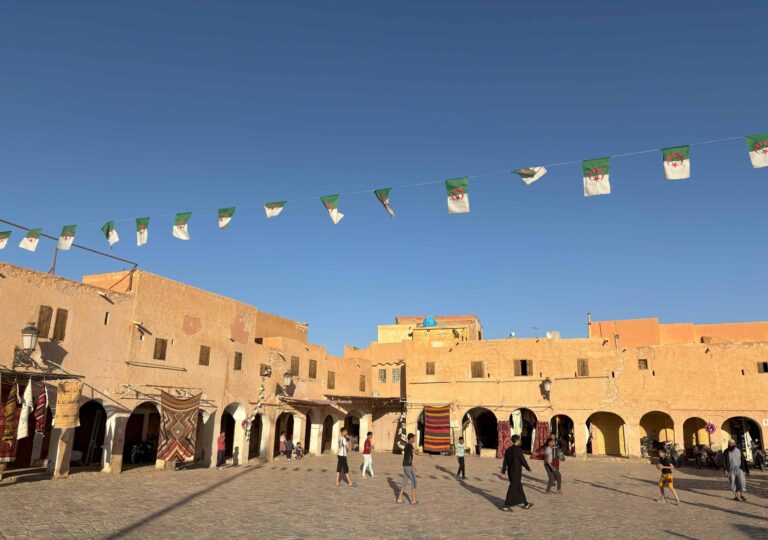
We flew to Ghardaia from Oran and as far as we could tell you can travel there by bus or share-taxi too. Once in Ghardaia, although the police stopped us at the airport immediately (more on that later) – it was completely fine. We could freely roam around the principal town in the oasis and in-between the other towns. You do need a guide inside the walls of the old towns in the M’zab valley – but these are easily arranged at the entrance to each one.
On a side note, we encountered literally no hassles or scamming-attempts here, no one bothered us. Quite the opposite, Algerians were super friendly and kind. We don’t speak Arabic or French, so that caused some difficulty but was absolutely not insurmountable. Just make sure you have a working SIM and Google Translate.
Weather
We went to Algeria in April when daytime temperatures ran from eighteen to high twenties Celsius. It rained a bit but was generally sunny, sometimes a little chilly in the north. Weather was not an issue for us in the slightest.
Cash or card? Exchanging money
Bring the entire cost of your trip in euros or dollars and change it as you go. Although you can withdraw money from ATMs in the cities or pay with card, you really shouldn’t. The official bank rates are terrible compared with the black market and the exchange you’ll pay when using your card is astronomical compared with paying cash (as long as you changed that cash on the black market).
On a side note, ATMs seemed pretty unreliable and often won’t accept foreign cards so I’d really only want to bother with one in a pinch.
We brought euros, which are the better option when it comes to exchange rates. At the time we were in Algeria, one euro equaled 149 dinars at the bank rate. On the black market rates vary (depending who’s offering) and the best rate we got was 252 dinars per euro – so you see what I’m talking about. Just shop around a little.
You can most likely change money at your hotel but we found much better rates at shops and convenience stores. In the streets and markets random guys will approach you and offer to exchange. Keep in mind: the black market is illegal.
Bring smaller notes to change on arrival. We arrived late and there were plenty of moneychangers wandering around the airport with terrible rates, and all the ATMs were out of service or wouldn’t accept our cards anyway.
Paying for hotels: if you’re booking hotel rooms ahead of time, remember when you convert the price of the room from dinar to your own currency, you’re getting official rates. Accommodation once you get there, and pay in the dinars you changed on the black market, is actually pretty cheap. So go ahead and book in advance if you want but make sure the payment option will be cash (dinar) on arrival, with nothing charged to your card.
We generally paid around thirty euros upwards for decent hotel rooms, usually including breakfast. Food, transportation, and tourist sites are very cheap – often just a couple of euros. We spent less than thirty euros a day for two people not counting hotels and flights.
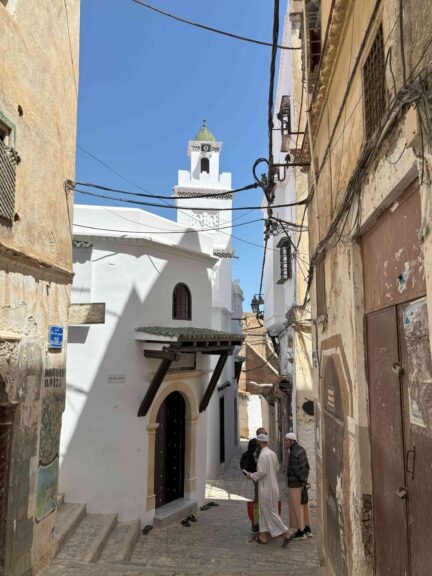
Getting around
Travel by air
Algeria is huge, domestic flights are cheap. Check out Air Algerie. We were on a short trip so we flew a few times. Flying is actually a good option (I can’t believe I’m saying that, but there you have it).
If you’re taking a domestic flight, be prepared for significant delays and a small amount of pointless chaos. Watch the boarding gates like a hawk. Gates seem to change frequently without any updates on the screens, and usually briefly announced in French or Arabic only. On one occasion a helpful employee actually came and got us as we sat at our posted gate, blissfully unaware that our flight had completely boarded from another gate at the opposite end of the concourse.
You’ll have to fill out ‘fiches’ – Departure and Arrival cards – and hand them in at every airport and get your passport checked, even flying domestic. Bring a pen. And patience.
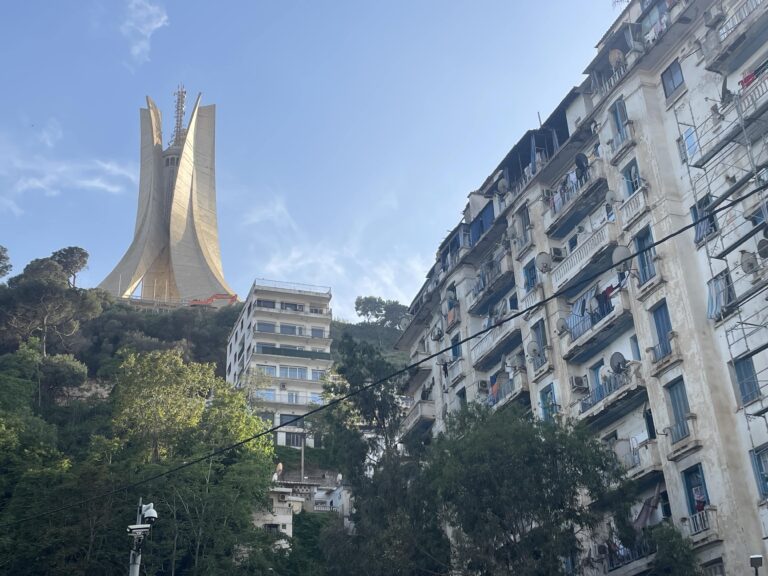
Travel by road
For local transport around a city, get yourself an app like InDrive, Yassir, or Heetch. We used InDrive almost exclusively and it worked well.
In the north of the country it’s no problem to zip along between towns by share-taxi, bus, or train. Not so much ‘zipping’ on the train, actually, they are notoriously slow. Just saying, it’s allowed. Of course in the southern/desert areas, transport won’t be an issue for you anymore since you’ll be on a tour.
We found share-taxis were the easiest and fastest option to move between cities. They’re also cheap and you don’t have to plan ahead – just show up, wait for the car to fill, and off you go. The roads are in good shape – be aware that drivers will speed. You probably won’t get a seatbelt. They generally take seven people including the driver. We also used a few private taxis (that we just negotiated in the street) to daytrip here and there.
Regarding land borders as far as we know, Tunisia is open, Morocco is closed. Mali, Niger, Libya – these are not only closed but also dangerous, and you shouldn’t be anywhere near them. Possibly the same goes for Mauritania.
Speaking of Mauritania, riding the rails on the famous iron ore train is apparently off-limits at the moment. But you can still check out this post about our experience on the iron ore train.
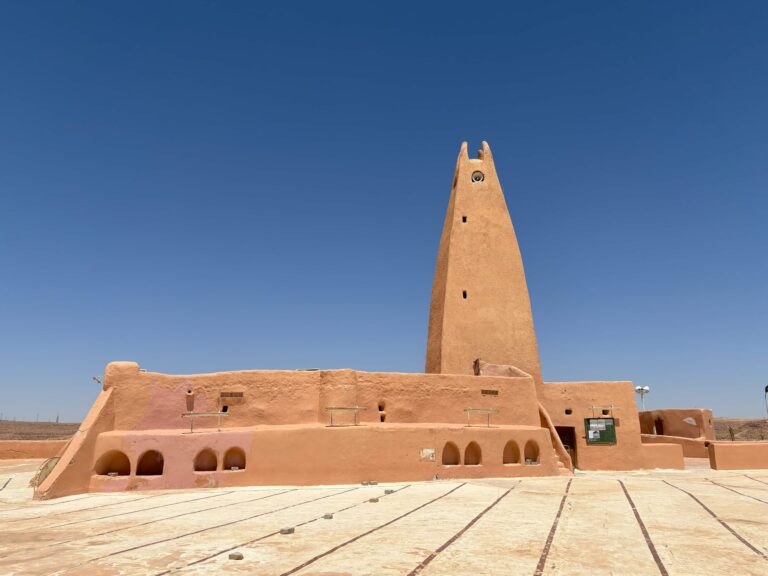
On the road – our itinerary
Here’s the itinerary we made for the eleven days we spent in Algeria.
Day 1 Algiers
Day 2 – 4 Oran
Day 5 – 8 Ghardaia
Day 8 – 10 Constantine
Day 11 Algiers
Algiers
We landed in Algiers around midnight and processed immigration quickly. The airport is about thirty minutes from the city centre. With and Airalo e-SIM and InDrive ready to go we got a ride to town.
There’s a good local transport system with buses, metro, and streetcars. It’s a big city but if you stay centrally most sights are fairly walkable. Don’t forget to look up: Algiers has a lot of grand architecture.
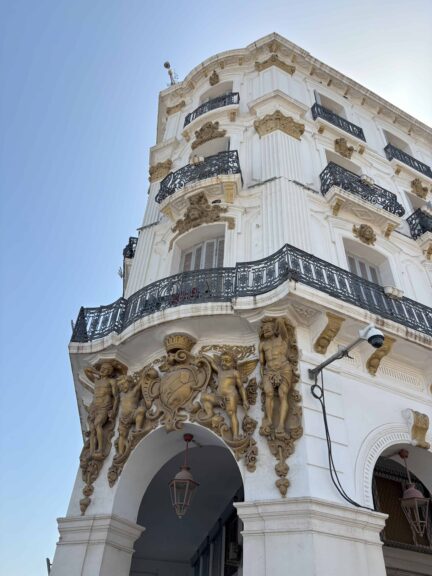
The museums aren’t much to write home about for English speakers since everything’s in Arabic and French only.
But don’t visit Algeria without a wander in the narrow alleys amongst the souks, hammams, and mosques of the the capital’s Casbah, or ancient medina.
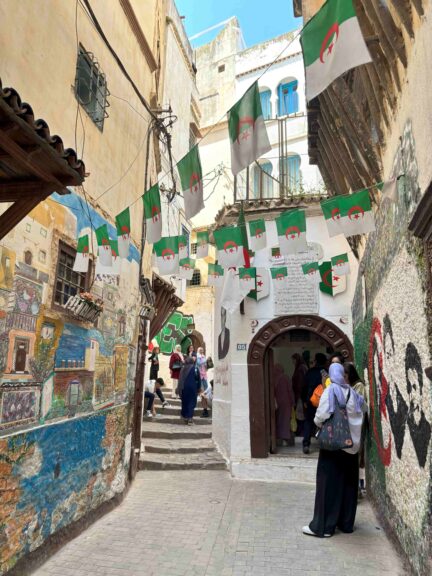
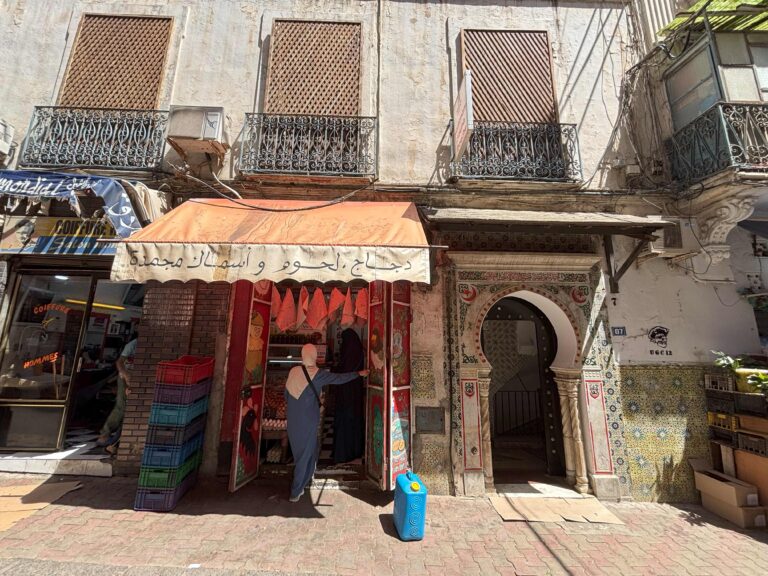
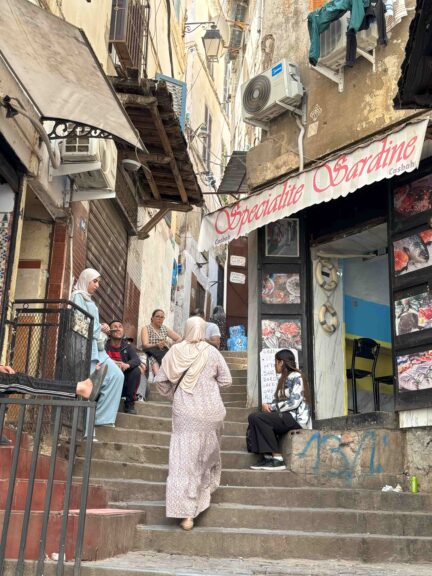
We had the only drink of the trip (local wine no less) at Hotel El Djazair. We really liked the hotel’s historical vibe and would have stayed there if we’d known about it in advance.
Two full days in Algiers is a good amount of time to see it and to eat a bunch some of their delicious sweets. Get yourself a big old plate of couscous (if you don’t…don’t worry about it. It’s everywhere). Algiers is also where we first encountered chakhchoukha, a sort of chopped-up-pasta dish. Carb-overload, and pretty tasty.
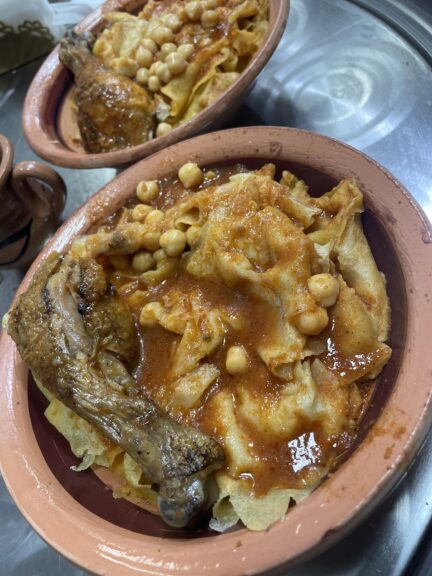
Straightaway, on our very first day – we started noticing the friendliness and welcoming hospitality of Algerians. That didn’t change the whole time we were there, and was one of the best parts.
Oran
Even though many of Oran’s buildings are in a state of decay it’s nice just to walk around the city and image life here a century ago. The architectural influence from both the Spanish and French is very obvious on a stroll through the center and it’s an atmospheric place, often called ‘Little Paris’.

Little Paris, big Algeria: we flew from Algiers to Oran. That being said, the roads are so good and share-taxis so frequent and easy (and flights so frequently delayed) I’d just go by road next time.
Although it’s the second biggest city in the country, it’s considerably smaller than Algiers and makes for some easy chill days. Two days exploring on foot worked just fine for us.
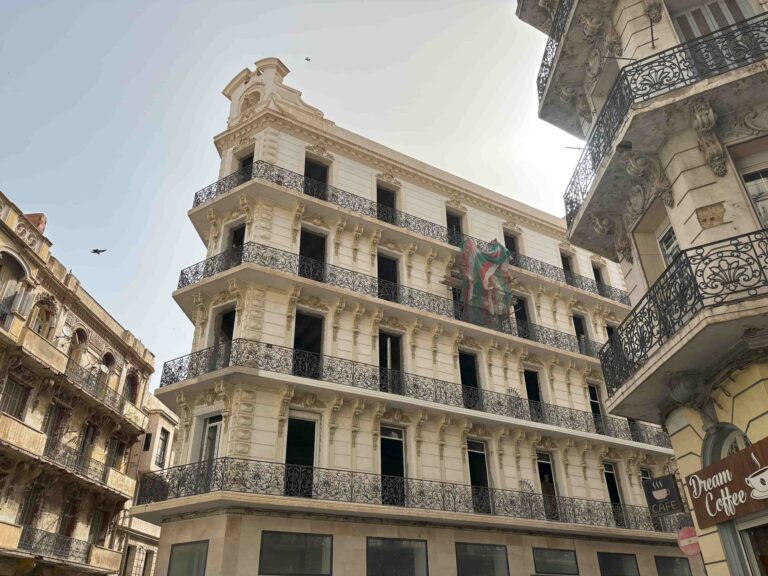

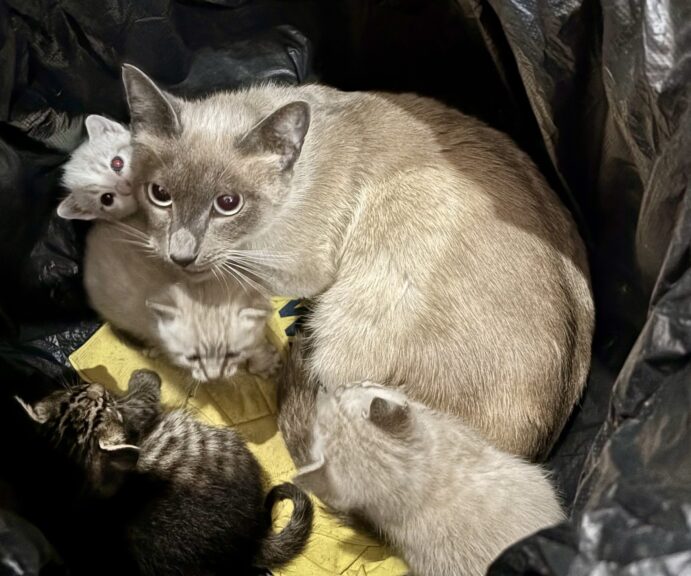
To reach the Fort of Santa Cruz you ride a cable car from Magenta cable car station in the city center. At the top you can find a taxi to take you down to the fort or walk about forty minutes. Then you ride the cable car back down to the city. Apparently walking all the way to/from the city is not a good idea, we were warned off doing this by our hotel.
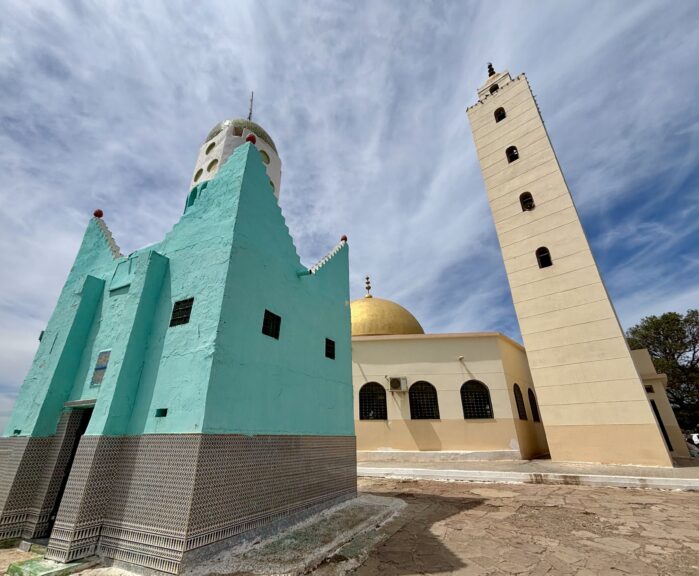
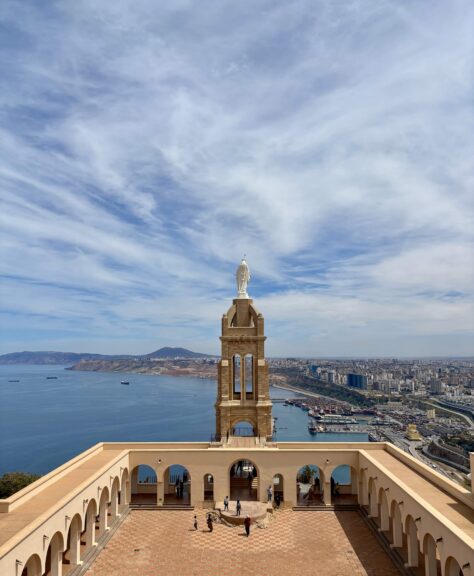
We stayed at Hotel Les Ambassadeurs which we liked. It was the only hotel we paid for with card in advance, so that means we paid at the bank rate – i.e. a lot more than the cost paying cash on the spot. It was the only hotel we encountered which required payment in advance.

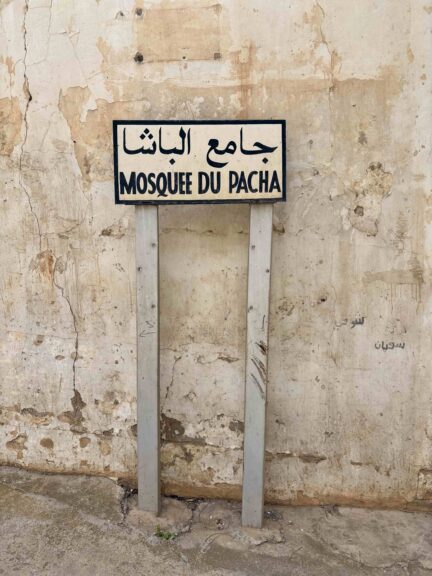
Overall we didn’t love the food in Oran or anywhere else in Algeria, but again we did get a lot of good breads and fruit and dates in the markets, and sweets and coffee in cafes.

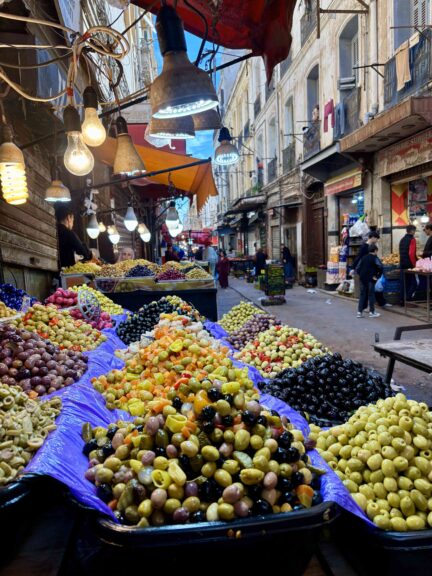
Ghardaia
Ghardaia – five towns clustered together in the desert, the gateway to the Sahara. These quiet fortified towns are home to the Mozabite people who broke from mainstream Islam and founded the pentapolis about a thousand years ago. Silence reigns inside the walls where the only traffic is donkeys (…or the occasional motorbike), and ghostly women flit by covered in white wraps from head to toe, only one eye exposed.
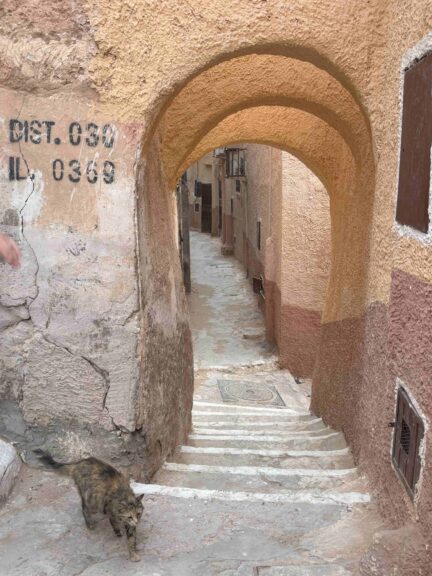
We flew from Oran to Ghardaia. Next time I’d go by road, not a lot more time-consuming and for the reason below.
Arriving by flight, you should arrange a pickup in advance because the police meet foreigners right off the plane and want to know your plans. We’d arranged a ride through our Airbnb host and had the driver’s number. The instant we walked off the tarmac and into the little airport, a police officer stopped us. He asked where we were staying and who was coming to get us. He had us call the driver so they could talk to him. We waited about twenty minutes until they gave us back our passports. Then we drove with a police escort to town. There seems to be no reason for this beyond formalities, but everyone was friendly. From what we’ve read there are none of these formalities if you arrive by public transport, and after the police escort from the airport, we never saw them again – including for the trip back to the airport, later.
Security in this particular area hasn’t been an issue in a long time but still some procedures seem to linger.
The taxi cost 2000 dinar and took half an hour to Ghardaia. Ghardaia is the biggest of the five main Mozabite towns and the most convenient place to stay in the area.

Beni Isguen, Bou Noura, and Melika are within walking distance from Ghardaia. You can get to El Atteuf in forty-five minutes on bus number 30 from Ghardaia. You can also hire a taxi to drive you around to the towns but honestly I’d say that’s pointless, they’re very easy to just go yourself.
The inhabitants of the ancient fortified towns are concerned about protecting their heritage and will only allow visitors in with guides (that includes Algerians from the rest of the country, too). The smallest of the towns, Melika, is the only one where nobody imposed this rule when we were there. Quite the opposite in fact: we asked for a guide and couldn’t find one. The other four towns where we had guides were much more interesting to us than Melika, where we wandered around empty streets alone.
The towns allow visitors entry from about 09:00 until 13:00, and then again from 16:00 til 18:00. You can’t miss the Tourist Offices, they are just past the main entry gates inside the walls. That’s where you pick up your guide. Prices are posted and ranged from 250-500 dinars per person, depending on group size – there were usually tour groups around. In most cases somebody called and tracked down an English-speaking guide for us. All the guides we met were really informative and the tours were good.
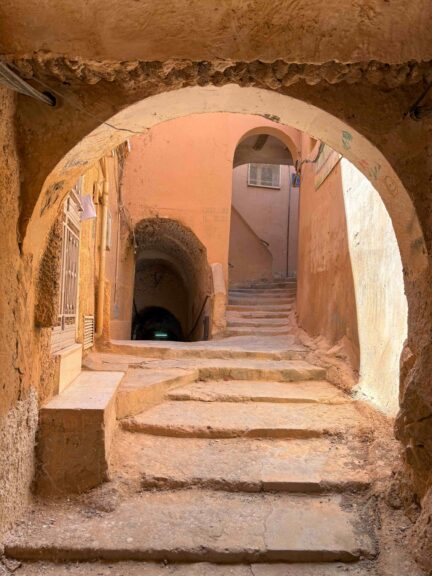
In general:
- In Beni Isguen there’s an auction every night so if you want to catch that, go around 17.00.
- You get great views from the top of the ancient towers in Beni Isguen. Unless there’s a sandstorm.
- Ghardaia itself is most interesting in the morning when the market is full-swing.
- Photographing the women dressed in the traditional white wraps, called Ahuli, is strictly not allowed.

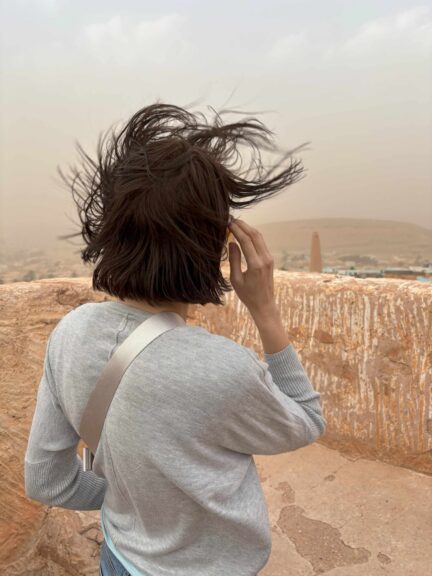
You’re not spoiled for choice foodwise, but on the way to Beni Isguen there’s a restaurant called El Djawhara which we liked and so clung to for dear life. A few hundred meters away from that one is another ok restaurant with a traditional Berber interior called Restaurant Khaima Hamma.
Overall, we ate a lot of dates. Dates were the staple crop and valuable here for a long time, and still are grown and consumed by the ton.
Constantine
Constantine’s big draw is its stunning location. The ‘City of Bridges’ is perched on the edge of a deep gorge, with seven iconic bridges spanning the Rhumel river far below.

Besides that, Algeria is home to the second-largest number of Roman ruins after Italy. Staying in Constantine puts you in daytripping proximity to two of these evocative Roman cities: Timgad and Djemila. Founded in 100 AD, abandoned by the 7th century, these ruins are some of the best preserved Roman cities in North Africa.

Today, this means sunny days rambling around Roman baths, villas, mosaic-tiled houses, forums, and temples.
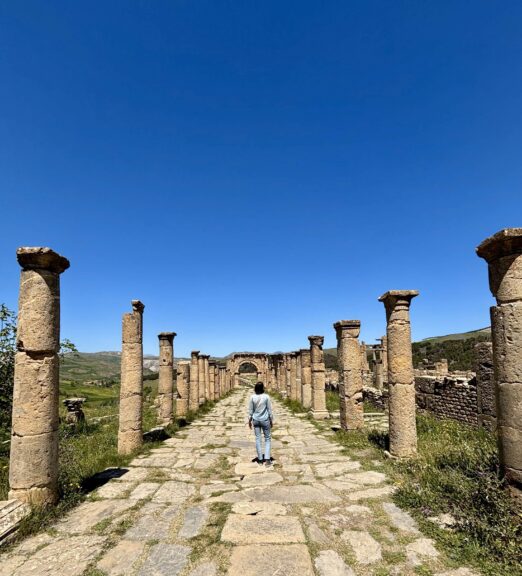
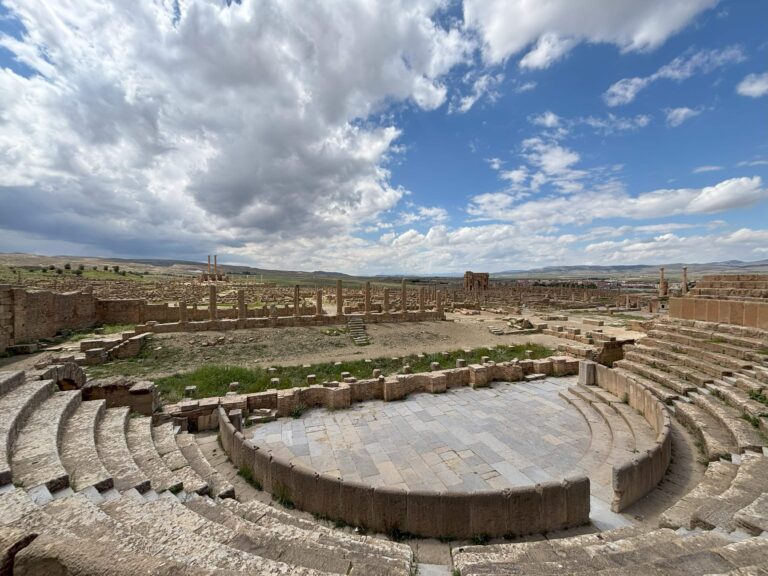
We made a separate daytrip to each one. We asked around in the street and negotiated with a couple of taxi drivers, then hired one and paid 7000 dinar the first day to Timgad and 8000 dinar on the second day to Djemila. On the second day we also had the driver take us around to all the bridges when we got back to Constantine. Both daytrips were about seven hours with driving time, a couple of hours at the ruins, and stops for lunch.

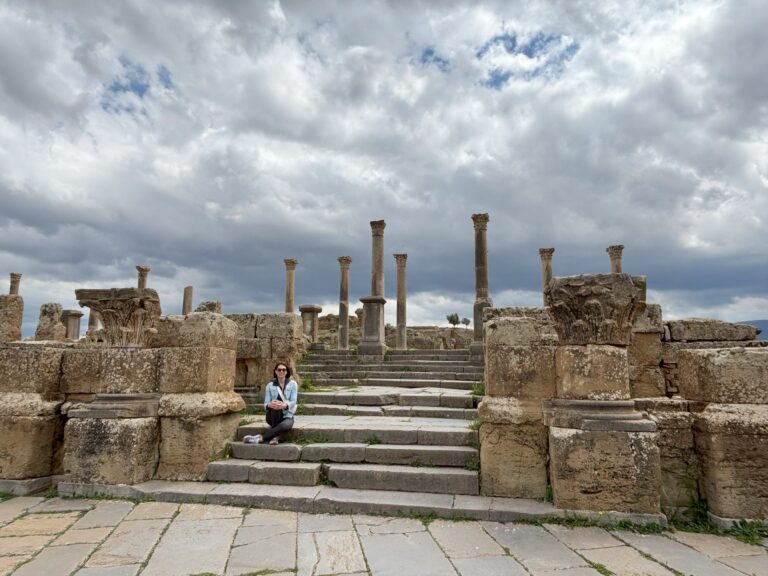
You can also do these daytrips by patching together share-taxis, buses, or a couple of private taxis. It’ll just take a lot longer.
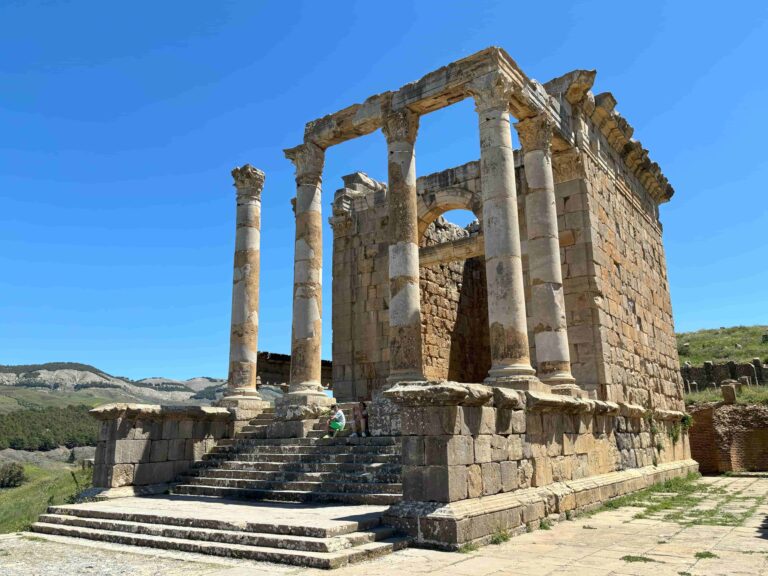
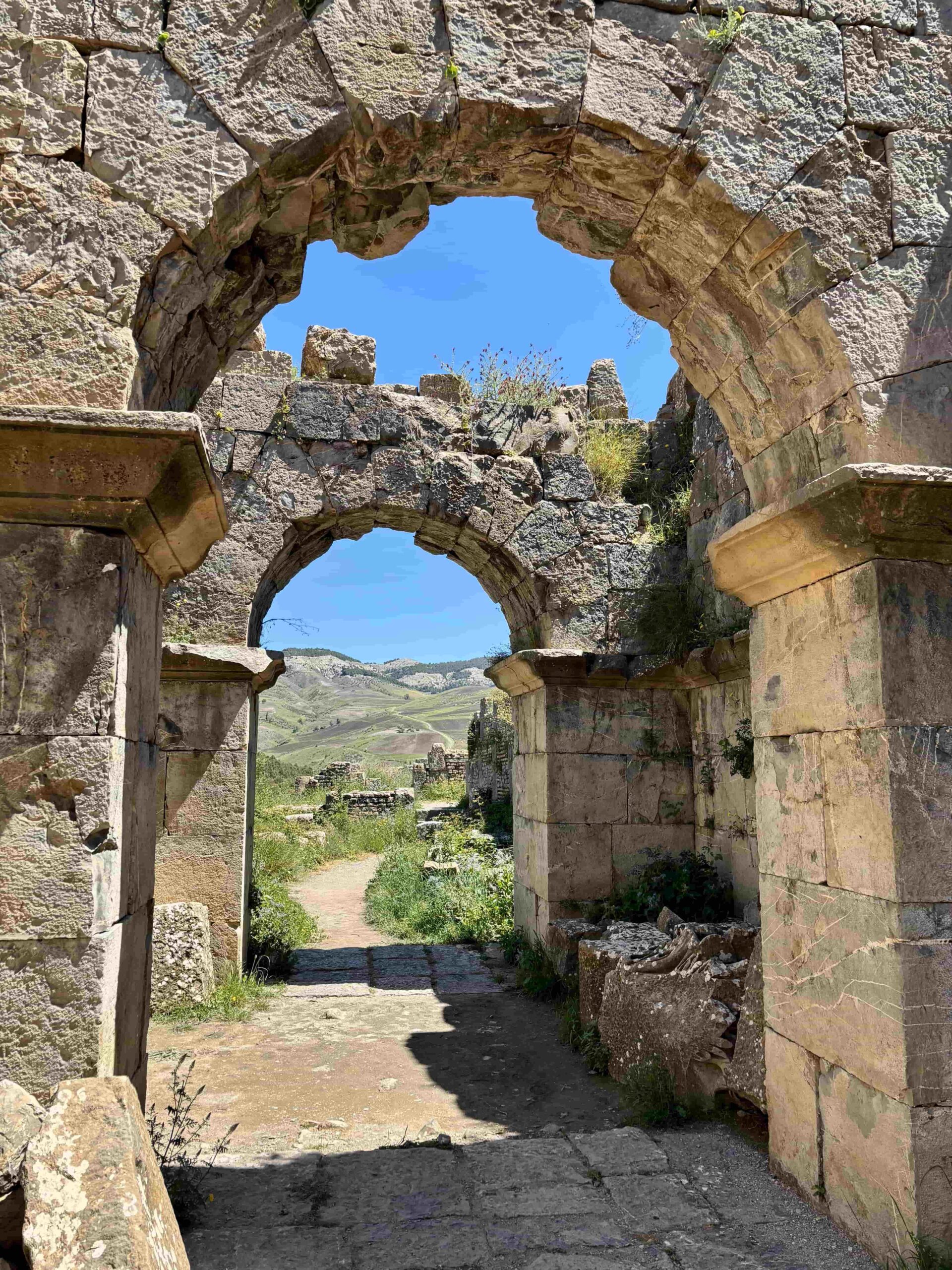

Both ruined cities were incredibly intact. Our favourite was probably Djemila, the spacious setting is really beautiful.
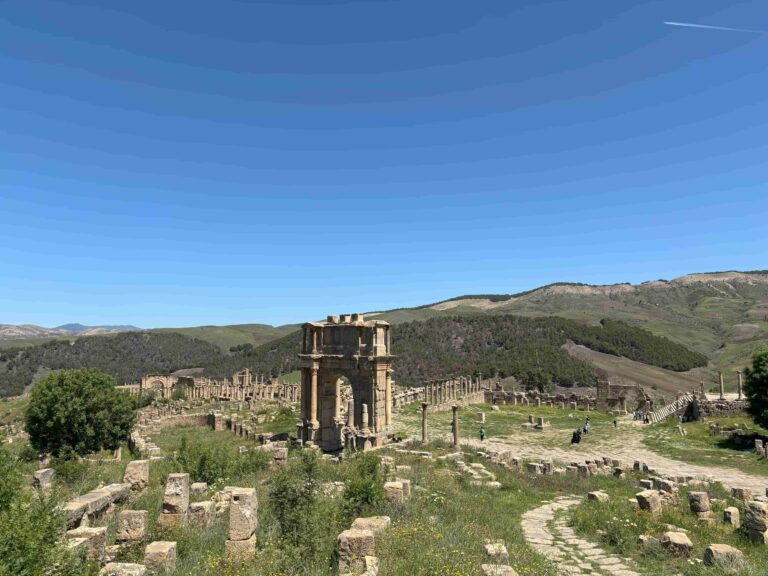
We left Constantine in a share-taxi from Sahraoui/Gare routiere est, to Algiers.
If you want to go by train, you’ll need to go to the station in person to check departures and buy tickets. In addition to leaving and arriving at inconvenient times, the train takes much longer than the share-taxi.
…and back to Algiers
We came back to Algiers by share-taxi from Constantine. That took about four hours, plus a short time waiting for the car to fill. The driver made a lunch stop along the way at a highway rest station – this was seriously the best food we ate the whole time.
We arrived at the Kharouba Interstate Taxi stand and got a ride on InDrive the rest of the way into the city from there.
Read More
Check out the Destinations page for travel guides and stories about our other off-beat adventures all over Africa and beyond.

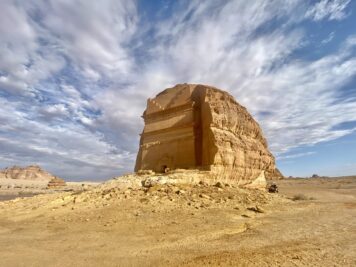

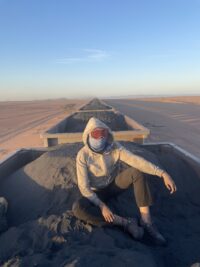
This Post Has 2 Comments
Can I ask what month you visited? My family and I want to go in the middle of June when the school year ends, but not if it will already be crazy hot.
Sure, we went in April. Very comfortable temperatures at that time.